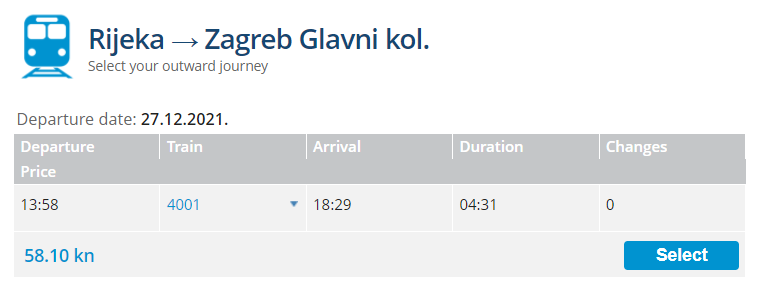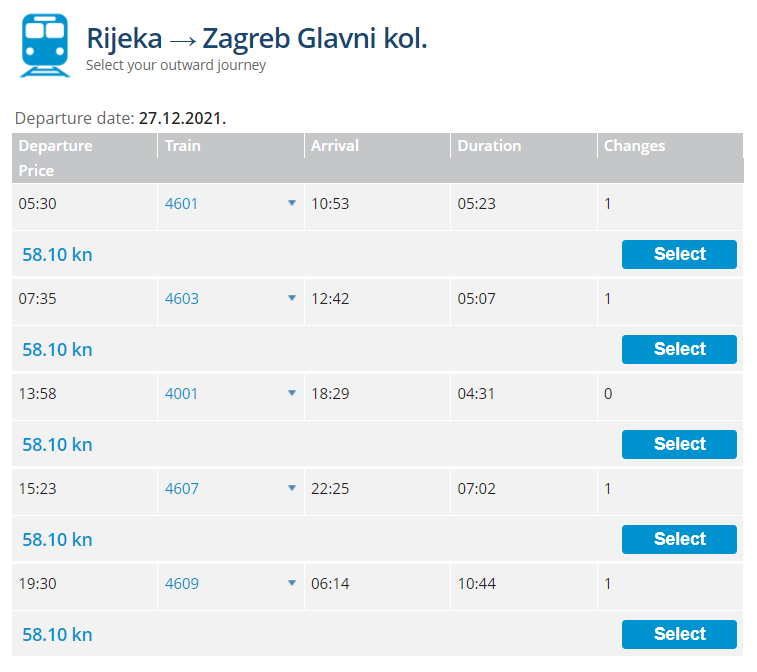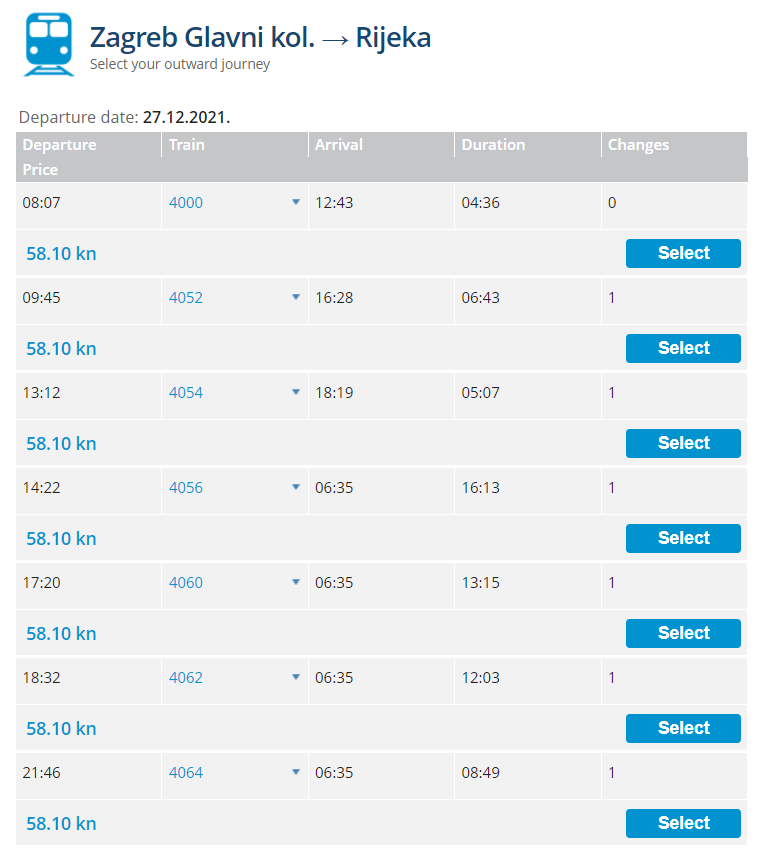Travelling from Zagreb to Rijeka by Rail? You Might Want to Reconsider
Railway connectivity between the capital and the biggest Croatian port has been more than inadequate lately, with no express lines available and a single direct line in operation
Rijeka city councillors Ivana Prica and Kristian Čarapić of SDP criticised the poor railway connectivity between Rijeka and Zagreb at a recent press conference, reported Novi list (Marinko Glavan). The councillors demanded that the Croatian Railways (HŽ) reinstate the high-speed train line between Rijeka and Zagreb that was scrapped last year.
‘The last remaining express service operating on the route Rijeka-Zagreb-Osijek was cancelled on December 24th of last year, while the express line Zagreb-Rijeka-Zagreb has been scrapped even earlier. It thus became impossible to travel by rail from Rijeka to Zagreb and back on the same day. It’s shameful that the capital city and the biggest port in Croatia aren't better connected in terms of railway passenger transport’, they said.
A quick search of the HŽ booking page reflects the painful reality of travelling by rail in Croatia. Not only is there no express service between Rijeka and Zagreb, but there’s only one direct line connecting the two cities at present. That particular trip takes 4.5 hours, a tedious ride compared to 2 - 2.5 hours it takes to get to the capital by bus or little over 1.5 hours if you’re travelling by car.
Other four available services involve a change of train halfway through and take anywhere from 5.5 hours for an early morning service to almost 11 hours in case of a night line:
Trip duration listed on the timetable is the best case scenario. The site warns that ‘due to work on certain sections of the railway, deviations from the published timetable are possible’. This is a frequent occurrence that’s more than likely to extend the duration of your trip by an hour or two and involves a transfer from a train to a bus.
The timetable could use some work as well. The only direct line departs from Rijeka at 1:58 PM and arrives in Zagreb at 6:29 PM. It’s unclear who would find this convenient, as you’d technically waste half a day before departure and would effectively be forced to stay in Zagreb overnight in case you need to get anything done.
There are two morning lines, departing at 5:30 and 7:35 AM, but they only arrive in the capital at 11 AM and 12:42 PM respectively. If you opted for one of these, you’d have no way of getting back to Rijeka on the same day, unless you were willing to either hop on a return train an hour after your arrival, or endure a 13-hour overnight train ride. Here’s the schedule:
The only direct line from Zagreb to Rijeka departs at 8 in the morning and also has a 4.5 hour trip duration. The timetable doesn’t match a normal workday schedule, and frequent travellers on this route - such as college students - essentially don’t have a choice but to travel by bus.
It’s a shame, as travelling by rail is not only more comfortable than taking a bus, but is also the most sustainable mode of passenger and freight transport.
Bus lines between Zagreb and Rijeka (and vice versa) are much more frequent, with several companies operating on the route and departing every hour or so throughout the day.
There’s not much to complain about on that front, except if you were looking to make a day trip to Zagreb during the holiday season. The last Zagreb-Rijeka bus departs at 7 PM on most days (weekends included), so if you were hoping to revel in the festive spirit of Advent in Zagreb, you’d be limited to daytime activities.
Arguably, Christmas markets are best enjoyed in the evening, and you’d have an hour or so to get a cup of mulled wine and appreciate the sparkling lights before hurrying back to the bus station. This goes for those travelling back to Istria as well, as the mentioned 7 PM service is also the last one that continues on to Pazin and Pula after a stop in Rijeka.
Perhaps a good way for the capital to generate more overnight stays in December, but considering how popular Advent in Zagreb has been in recent years, it could use a few more bus lines in evening hours to accommodate those who don’t necessarily want to spend the weekend.
Croatian Railways' Lepoglava Junction Project to Boost Rail Connectivity
ZAGREB, 12 Dec 2021 - The HRK 4.4 billion (€586 million) project of the Lepoglava Rail Junction aimed at improving the railway connectivity of three northern counties -- Međimurje, Varaždin, and Krapina-Zagorje -- with the City of Zagreb has recently been presented in the city of Varaždin.
The purpose of the project is to boost the railway connections between key railway stations in central Europe and Zagreb, provide passengers with the shortest railway routes in the region, and offer fast and eco-friendly travel by rail.
Marko Car, an engineer of the Croatian Railways' HŽ Infrastruktura, said that the project envisaged the upgrade of 70 kilometers of the existing rail lines and the construction of an additional 20 kilometers of lines for the junction.
The implementation of the EU-funded project can take 20 years.
The selected 92-kilometer-long route, which includes nine railway stations and 17 train stops, and two tunnels, will make it possible for trains to develop a speed up to 120 kilometers per hour.
The preparation of the necessary documentation will cost HRK 6.7 million (€890,000).
As much as 85% of the total project is being financed from the 2014-2020 Operational Program Competitiveness and Cohesion.
The study documentation has been drawn up by the consortium comprising ŽPD, Granova, Institut IGH, and Rijekaprojekt.
For more, check out our dedicated politics section.
Fully Developed and Modernised Croatian Railway System in 10 Years?
November the 24th, 2021 - The Croatian railway system has needed a ''lick of paint'' for some considerable amount of time now, and with this more sustainable way of travel being promoted on all levels by the EU, the Croatian railway system hopes to be fully developed and modernised in 10 years.
As Poslovni Dnevnik/Darko Bicak writes, railways are the main and key mode for the development of the sector of the future in the whole of the bloc, including Croatia, it was said at the panel discussion "Modern railways in a liberalised market" organised by the Ministry of Maritime Affairs, Transport and Infrastructure, Hakom and the Alliance for Railways held on Monday in Zagreb.
Tonko Obuljen, President of Hakom's council, pointed out that a regulated market in which the exact rules will be known and within which everything will adhere to the precondition for the good functioning of the railway system is key. State Secretary at the Ministry of Maritime Affairs, Transport and Infrastructure, Alen Gospocic announced that after the stabilisation of the situation in the road sector, the ministry is now moving towards the restructuring and modernisation of the Croatian railway system.
“Over the next decade, we want to have a developed railway system that provides quality services to society and is fully integrated with other branches of transport. There's also the establishment of a single European railway area which will lead to the consolidation of rail transport through long-term investment in infrastructure. First of all, I'm referring to two corridors which will run through Croatia, one of which leads from Slovenia to Serbia and the other from Hungary to the Port of Rijeka,'' said Gospocic.
EU funding for the Croatian railway system...
He added that he expects that most of these investments will be realised through the European Recovery Plan, from which more than 4.5 billion euros could be withdrawn for precisely that. According to him, what has already started is the restructuring of HZ Infrastructure so that they can be more functional, and also so that they can apply for EU tenders.
The pandemic is a circumstance that has caused great damage to rail passenger transport across the world, due to lockdowns, the general lack of travel, but also the requirement to limit the number of passengers who can be in one car at any one time. The State Secretary announced that there will be reorganisations of HZ Passenger Transport, which will receive about 80 new trains in the next 3 to 4 years, mostly from the local Koncar plant.
The European Commission has declared 2021 the European Year of Railways, as part of European Union efforts under the European Green Plan, a plan drawn up by the EU with the aim of creating a sustainable economy and achieving climate neutrality by the year 2050. One of the key elements of this plan is to launch cleaner and healthier modes of transport, as the transport sector is currently responsible for 25 percent of Europe's greenhouse gas emissions.
The European Green Plan calls for a 90 percent reduction in emissions in the transport sector by 2050 and the activities within the European Year of Railways are intended to provide momentum to increase the share of rail transport across the bloc's transport market as a whole.
Through various events, projects and activities held across the bloc, different dimensions of railways stand out, from the world's leading European railway innovation industry to the role of railways in European culture and heritage, the important role of connecting regions, people and businesses and the role of sustainable tourism, as well as its involvement in Europe’s relations with neighbouring non-EU countries.
A sustainable mode of transport
While the European transport sector is responsible for 25 percent of greenhouse gas emissions, at the same time, railways across the European Union are responsible for less than 0.5 percent of transport-related greenhouse gas emissions. This makes it the most sustainable mode of passenger and freight transport we currently have.
Among other advantages, travelling by rail is extremely safe and connects European people and the economy via the Trans-European Transport Network (TEN-T). Despite these benefits, only about 7 percent of passengers and 11 percent of goods are actually transported by rail. These are all facts that prompted the European Commission to launch a complex project to organise the European Year of Railways.
For more, check out our business section.
Croatian Railways Slashes Train Ticket Prices from Zagreb to Coastal Cities
May 16, 2021 - Croatian Railways has launched a sale on train ticket prices from Zagreb to coastal cities in Croatia!
HRTurizam reports that Croatian Railways Passenger Transport (HŽPP) has announced special prices for travel on direct routes from Zagreb to the coast.
Prices refer to one-way trips on direct routes in the 1st and 2nd class of passenger, high-speed, and IR trains for which tickets are purchased at the box office and on the train. Also, HŽ stated that the prices of tickets purchased through online sales and smartphone applications had been further reduced, and train tickets can also be purchased at Tisak kiosks.
Train ticket prices from Zagreb
Zagreb GK - Rijeka / Rijeka - Zagreb GK 65 kn
Zagreb GK - Zadar / Zadar - Zagreb GK 100 kn
Zagreb GK - Šibenik / Šibenik - Zagreb GK 100 kn
Zagreb GK - Split / Split - Zagreb GK 110 kn
Zagreb GK - Pula / Pula - Zagreb GK 80 kn
The offer is valid until June 30, 2021, and the return of partially or completely unused tickets is not possible.
2021 is the European Year of Railways
The European Commission's (EC) initiative highlights the benefits of rail as a sustainable, smart, and safe means of transport. In 2021, various activities will bring rail to the forefront across the continent, encourage citizens and businesses to use rail, and contribute to the goal of the European Green Plan, according to which the EU should become climate neutral by 2050.
One of the key elements of the Plan is the introduction of cleaner and healthier means of transport, given that the transport sector is currently responsible for around 25% of EU greenhouse gas emissions. The European Green Plan calls for a 90% reduction in traffic emissions by 2050.
To achieve this goal and ensure that transport continues to play a role during the transition to a clean, digital and innovative EU economy, the EC adopted a Sustainable and Smart Mobility Strategy in December 2020. It paves the way for more sustainable, smarter, and resilient mobility and includes milestones towards doubling rail freight by 2050 and tripling high-speed rail connections by 2050. In 2021, the EC will present an action plan to strengthen rail passenger transport, which follows the strategy to improve capacity and simplify the system of ticket sales for various modes of transport to increase the attractiveness of rail further.
For more on travel in Croatia, follow TCN's dedicated page.
Istria Railway Renovation to Revive Line from Slovenian Border to Pula
April the 17th, 2021 - The Istria railway lines are set to have a bit of life breathed back into them after a significant period of time. More precisely, the renovation of the part of the Istria railway line from Pula to the Slovenian border is set to begin.
As Poslovni Dnevnik/Suzana Varosanec writes, with the signing of the Agreement on the preparation of the study documentation for the reconstruction and modernisation of the railway R101 (Slovenian-Croatian border - Buzet - Pula), new opportunities for the modernisation of this traffic route are being realised.
On top of the aforementioned, new life on this part of the Istria railway line means greater prospects for the tourist revitalisation of central Istria through new modes of transport.
For the 91 kilometre-long dilapidated railway line that passes through the continental part of Istria - from the border with Slovenia to the City of Pula, the study documentation includes the development of conceptual solutions, cost-effectiveness studies, a cost-benefit analysis, and an extensive review of the proposed environmental impact of such a move.
Thus, the needs and possibilities of modernisation will be considered, acceptable options and investments will be analysed in relation to the planned transport demand, and it will serve as a basis for the further elaboration of this project and application for potential European Union (EU) co-financing.
As a co-signatory of this Agreement with HZ Infrastruktura, the Ministry of Maritime Affairs, Transport and Infrastructure, when it comes to the further development of Istria, places the greatest emphasis on developmental projects, including the completion of the Istrian Y and continued construction in regard to the Ucka tunnel.
With the signing of this brand new agreement, as a step forward, the modernisation of the Istria railway infrastructure in that part of the country is set to formally begin.
For all you need to know about the Istrian city of Pula in 2021, make sure to check out Pula in a Page.
Strike at HŽ Infrastruktura Railway Company Called Off
ZAGREB, 24 March, 2021 - Three representative railway workers' unions whose members are employees of the HŽ Infrastruktura railway company have called off a strike announced for noon on 25 March after reaching a compromise solution and signing a new collective agreement with the employer.
The leader of one of the three unions, Mario Grbešić, told Hina that the dispute with the employer had been about two provisions, one being a non-taxable wage supplement and the other meal allowances.
"An agreement has been reached concerning these two issues in a satisfactory way. One will be implemented immediately and the other will be in force as of 1 January next year," Grbešić said.
Under the new collective agreement, to be in force from 1 April this year until 30 June 2022, as of 1 April workers have the right to a HRK 416 non-taxable wage supplement each month.
As of 1 January 2022, workers will receive a meal allowance of HRK 1.30 per each working hour.
They will also receive an Easter bonus of HRK 500, holiday pay of HRK 1,300 and a Christmas bonus of HRK 1,200.
The three unions that were planning to strike represent railway workers, train dispatchers and railway infrastructure workers.
The previous collective agreement expired on 28 February.
The unions further expressed their willingness to postpone negotiations on the cost of labour until the last quarter of this year considering the economic situation caused by the coronavirus pandemic and last year's earthquakes.
For more about politics in Croatia, follow TCN's dedicated page.
Chinese Stop Hrvatski Leskovac-Karlovac Railway Project Tender Again
March the 13th, 2021 - The Hrvatski Leskovac-Karlovac railway project tender has been forced to grind to a halt once again as the Chinese throw a spanner in the works in the form of another complaint.
As Poslovni Dnevnik writes, the Chinese have once again stopped the tender for the reconstruction/construction of the second track on the Hrvatski Leskovac-Karlovac railway section, worth a total of 2.04 billion kuna. The tender was launched back on September the 4th last year, and the first deadline for submitting bids was November the 3rd, 2020.
However, so far there have been a total of seven appeals against the tender documentation and its changes, which has extended the tender by more than four months, according to a report from Vecernji list.
The last complaint was filed by the Chinese company China Railway Eryuan Engineering Group (CREEG), more specifically its Zagreb branch, about ten days before the deadline for submitting bids was due back on March the 9th. HZ Infrastruktura sent a request to the State Commission for the Control of Public Procurement Procedures (DKOM) to continue the procurement procedure, despite the aforementioned complaint filed by a Chinese company.
HZI stated that CREEG's appeal was untimely and that the Chinese were merely abusing the institute of appeal with the sole aim of extending the deadline for the submission of bids. They also stated that they received money from European Union (EU) funds for the Hrvatski Leskovac-Karlovac railway project with the deadline for the eligibility of all expenditures until December the 31st, 2023.
Therefore, they warned that any further extension of the procedure could cause termination of the grant agreement, which could have an adverse effect on the entire Croatian economy. This would cause damage that would be greater than the value of the purchase itself, and that is one of the reasons, according to the Public Procurement Act, on the basis of which the continuation of the tender can be allowed despite the submitted Chinese complaint/appeal. Despite that, DKOM rejected the request on the grounds that HZI had not been able to actually prove what it claimed.
The Chinese company China Road and Bridge Corporation (CRBC), which is building the Peljesac bridge down in Dalmatia, also stopped this tender with an appeal filed on December the 4th, which DKOM rejected as untimely within just four days. It was then interpreted that the Chinese had filed the complaint to put pressure on the Croatian side over another tender - for a concession on the Zagreb coast in the Port of Rijeka, where they had made the best offer in a consortium with other Chinese companies.
However, the United States and the EU both put pressure on Croatia not to let the Chinese have access to the Port of Rijeka, and at the end of last year the tender was entirely annulled. Therefore, the new Chinese complaint for the Hrvatski Leskovac-Karlovac railway project might easily be interpreted as a kind of revenge for the Rijeka situation, but that is yet to be proven beyond doubt.
For more on business in Croatia, follow our dedicated section.
Continental Croatia Trains: Inland Opens Up With Green Travel
October 3, 2020 - With charter airlines in a state of flux and Croatia Railways beginning a renewal of their fleet in Slavonia, are continental Croatia trains the eco-friendly and best way to unlock the inland's amazing potential?
Everything changes. Nothing stays the same. Even before 2020 arrived, lifestyles and trends were headed in new directions. Eco-tourism and agro-tourism were two of the fastest-growing areas within the travel sector, this behaviour change a response to concerns about the environment. And nowhere in the country stands better poised to take advantage of this interest than continental Croatia.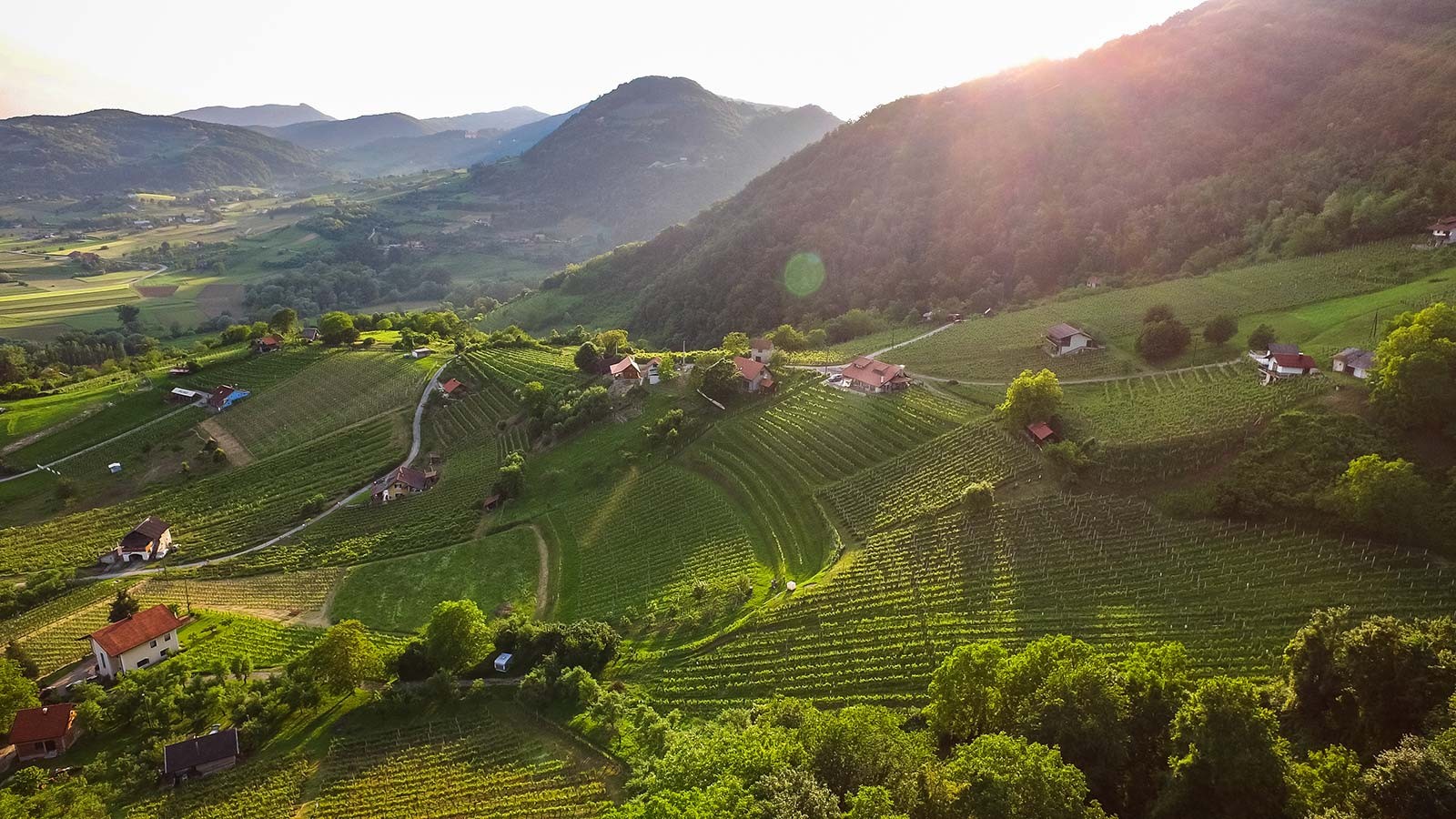 Impossibly pretty Zagorje - the region lies just north of Zagreb and is accessible by continental Croatia trains © Ivo Biocina / Croatia National Tourist Board
Impossibly pretty Zagorje - the region lies just north of Zagreb and is accessible by continental Croatia trains © Ivo Biocina / Croatia National Tourist Board
From the impossibly pretty hills of Zagorje, the peaceful rivers of Karlovac county and the hidden vineyards that surround the capital Zagreb to the vast Pannonian flatlands that stretch to Slavonia, Baranya, Vukovar-Srijem and beyond, the varied topography of continental Croatia is wild, exciting and - by many - wholly undiscovered.
This is land where agriculture and nature thrive side by side, where the stresses of modern-day existence ebb away as you readjust to a way of life that would look mostly familiar to the people who lived here centuries ago. These are places where you can truly be at one with yourself and with your surroundings. In continental Croatia, you often find yourself in an environment that is both timeless and traditional, yet wholly contemporary in regards to its ecological aspirations. And you're never far away from an exciting city environment that you can dip into on a whim – not just Zagreb, but Osijek, Slavonski Brod, Karlovac, Sisak and Varaždin too.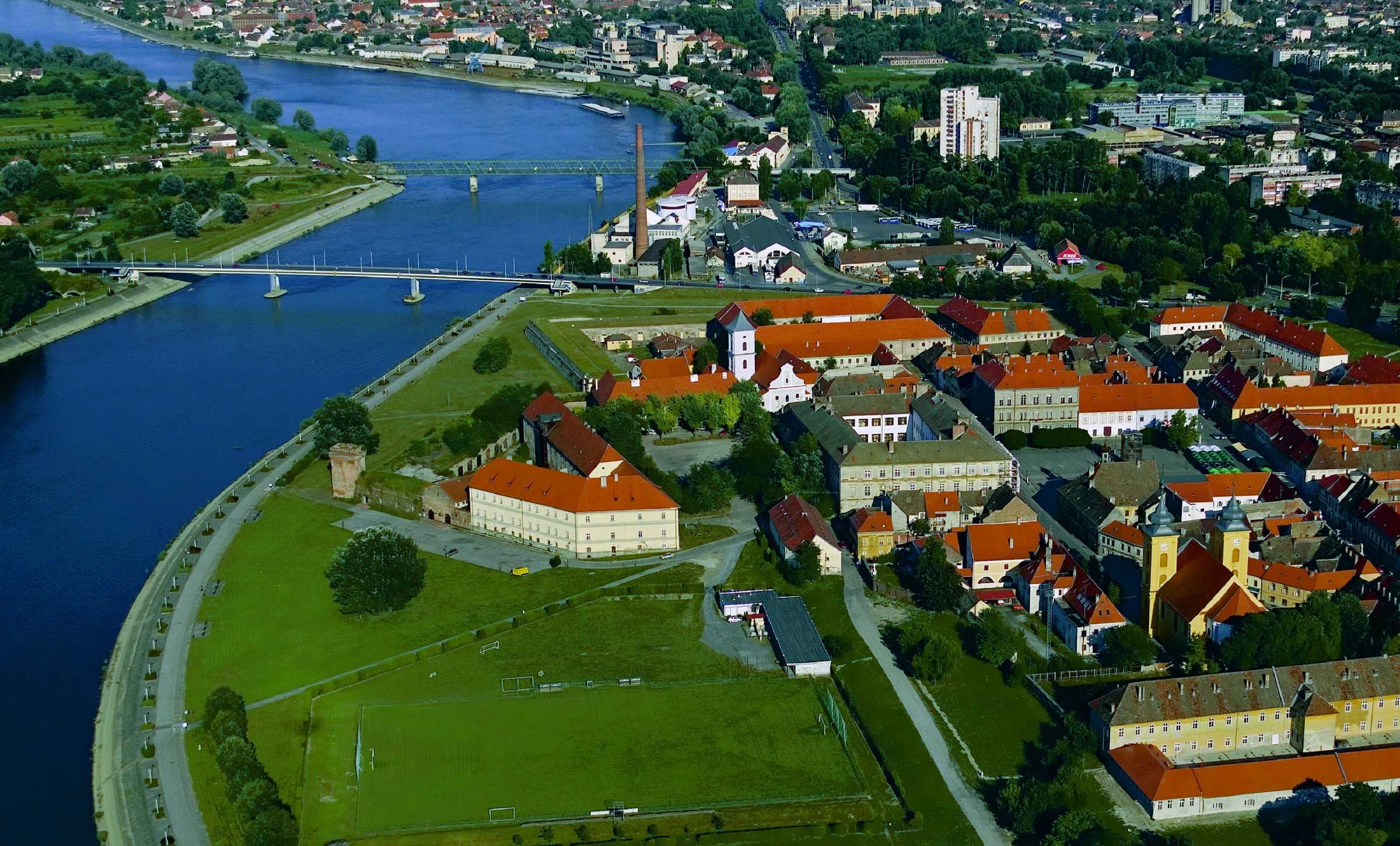 To those who really know and love Croatia, Osijek is simply unmissable. It is both the capital of and the doorway to Slavonia and Baranya and should be more accessible by continental Croatia trains. Sadly, international transportation links to the city by air are also quite poor. Improvements in accessibility to Slavonia and Baranya by rail and road are imminent © Romulić & Stojčić
To those who really know and love Croatia, Osijek is simply unmissable. It is both the capital of and the doorway to Slavonia and Baranya and should be more accessible by continental Croatia trains. Sadly, international transportation links to the city by air are also quite poor. Improvements in accessibility to Slavonia and Baranya by rail and road are imminent © Romulić & Stojčić
Unlocking the incredible potential of continental Croatia relies on getting the message out there and facilitating travel to these regions
In recent TCN features we have detailed that motorways within Croatia are among the best in Europe - once you're inside Croatia, travelling by car (or bus) between the regions couldn't be easier. We have also seen evidence of the huge interest in travelling here by rail and using continental Croatia trains.
Of all the modern methods of long-distance travel, rail is by far the most eco-friendly. What better way to begin an environmentally friendly holiday than by arriving on continental Croatia trains? When the country wisely decided to prioritise its internal motorway system, a modern and fast inter-regional rail network was put on the back burner. Nowhere suffers greater from this decision than continental Croatia.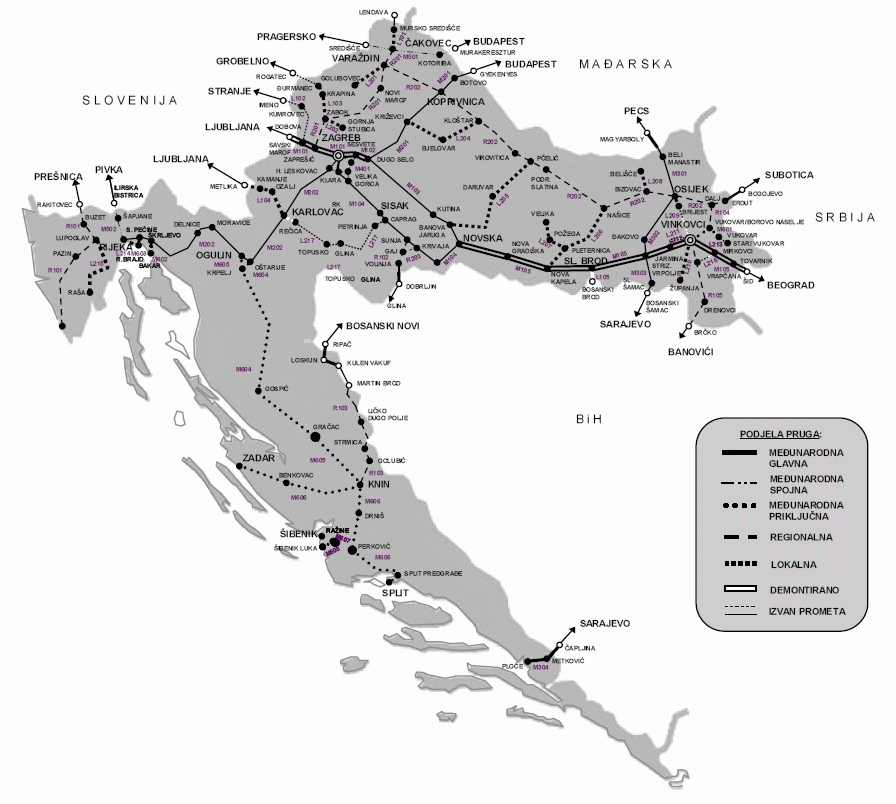 The Croatian rail network © Croatian Official Document uploaded to Wikipedia by Epepe
The Croatian rail network © Croatian Official Document uploaded to Wikipedia by Epepe
The only high-speed line that currently exists in Croatia links Rijeka to Budapest, via Zagreb and Koprivnica. Planned improvements hope to cut journey times between Zagreb and its nearest coastal city to an hour. Same as it ever was - Rijeka was the first Croatian city to be connected internationally by rail. That line also ran into the heart of Austro-Hungary and facilitated upper-class travel to places like Opatija. But does it best benefit the country to invest in more links to the coast or in continental Croatia trains? Well, the inland is not being ignored. Upgrades are being made to continental Croatia trains. This impressive beast actually services the country's coast. But would more investment in the continental Croatia trains network better service more people and help unlock the inland to tourists? Around 70% of the country's inhabitants live in continental Croatia © HŽPP
This impressive beast actually services the country's coast. But would more investment in the continental Croatia trains network better service more people and help unlock the inland to tourists? Around 70% of the country's inhabitants live in continental Croatia © HŽPP
The rail link between Zagreb and Slavonski Brod is so historic that it was once part of the four routes of the Orient Express. It has been maintained to a standard where you can make a relatively quick journey from the capital to Vinkovci via Slavonski Brod. The same cannot be said for rail travel to Osijek, the access point to Baranya and much more. So slow is the connection between Osijek and Zagreb that it has been possible over recent times to reach the Slavonian capital quicker by taking the train to Vinkovci, then the bus to Osijek, rather than travelling direct by rail. Osijek train station. A renovation to the building is planned for the near future © Romulić & Stojčić
Osijek train station. A renovation to the building is planned for the near future © Romulić & Stojčić
However, in February this year, Croatian Railways introduced four direct daily lines between Slavonski Brod and Osijek. And there will be a new tilting train line that will run between Zagreb to Osijek on Friday afternoon and from Osijek to Zagreb on Sunday afternoon, facilitating student travel. On October 15, the first low-floor train will run between Osijek and Vinkovci as an additional part of the renewal of their continental Croatia trains fleet in Slavonia. The welcome return of Croatia's second-oldest international rail line - linking Osijek to Pécs in Hungary, via Beli Manastir and Baranya - was introduced in late 2018.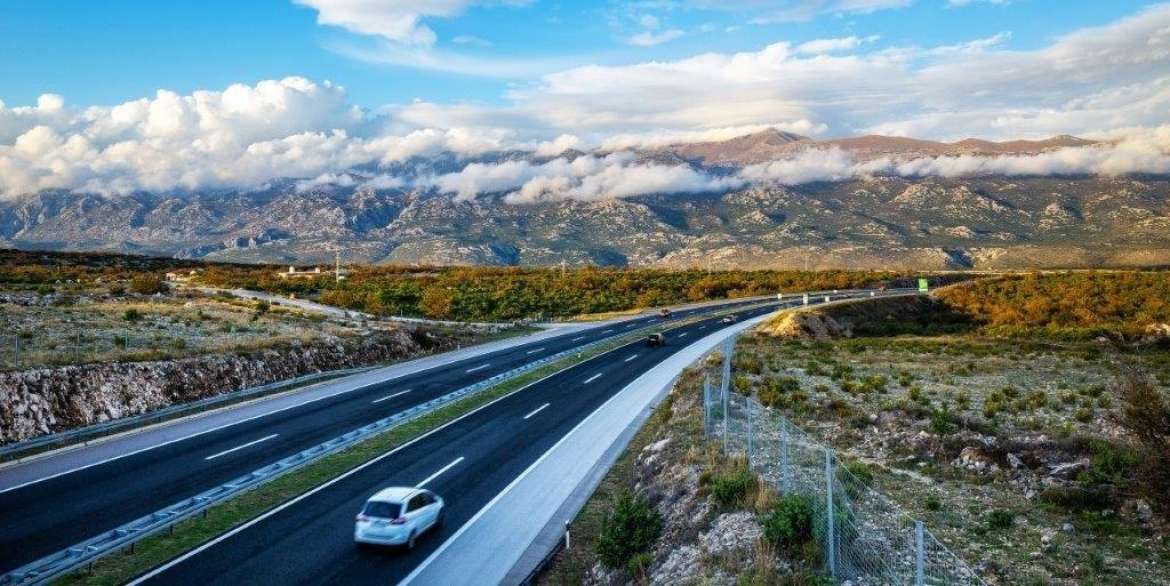 A motorway stretch between Metković and Dubrovnik, integrating the Pelješac bridge and the Croatian segment of the European corridor are the final big remaining projects in a three-decade-long undertaking to give Croatia one of the best motorway networks in Europe. Should Croatia's rail network be next? © Hrvatske Autoceste
A motorway stretch between Metković and Dubrovnik, integrating the Pelješac bridge and the Croatian segment of the European corridor are the final big remaining projects in a three-decade-long undertaking to give Croatia one of the best motorway networks in Europe. Should Croatia's rail network be next? © Hrvatske Autoceste
Access to Slavonia and Baranya will also be massively facilitated upon completion of the European corridor, which will connect North Europe to the Adriatic. Starting in Budapest, it necessitates the building of a bridge near Beli Manastir. Thereafter the motorway will pass by Osijek, connect to the Zagreb-Slavonia motorway near Lipovac, then pass through Bosnia and its capital Sarajevo and on to Ploče.
The removal of budget airline flights to the airport in Osijek remains a hindrance to attracting many international visitors to Slavonia and Baranya. However, with charter airlines facing the greatest uncertainty of all modes of transport at the current time, though their return is a must, it is perhaps now an ambition that should remain more long term. For the immediate future, improvements to rail travel look to be a brilliant way of opening up not only Slavonia, Baranya and Vukovar-Srijem, but also an eco-friendly access point capable of serving the whole of untapped continental Croatia.
For the latest travel info, bookmark our main travel info article, which is updated daily.
Read the Croatian Travel Update in your language - now available in 24 languages
Croatian Railways Investment Completion Set for Summer 2022
August the 31st, 2020 - Croatian railways aren't often in receipt of much praise. The train journeys are typically much longer than they should be, and the infrastructure system requires a lot of work. That being said, the Croatian railways investment has been going on since spring this year, and it isn't due for completion until 2022.
As Lucija Spiljak/Poslovni Dnevnik writes on the 30th of August, 2020, works on the reconstruction of the Zagreb Zapadni kolodvor - Savski Marof railway have been underway since back in May this year, the value of which amounts to almost 366 million kuna without VAT, and most of which is being financed by the International Bank for Reconstruction and Development.
This Croatian railways investment is part of a much larger investment cycle in transport infrastructure involving up to 20 billion kuna, half of which is going to the railway system, which, as stated, is in need of an upgrade. The works are expected to be completed by the summer of 2022, and the site was recently visited by the longtime Minister of Maritime Affairs, Transport and Infrastructure, Oleg Butkovic.
The eighteen-kilometre-long railway was last overhauled back in 1974, and this ongoing renovation should strengthen it, increase the carrying capacity and the level of safety and speed of trains to 120 km/h, and maintenance costs should be reduced in general. About 170 trains run on the line daily and it is located on an important corridor for international freight and urban-suburban transport.
During his visit, the Minister recalled the fact that the reconstruction of the Zapresic - Zabok railway saw an investment of around 900 million kuna in that micro-location alone.
He announced the continuation Croatian railways investments, and next week he will sign yet another contract for the purchase of 22 new trains for HŽ Putnički prijevoz (Passenger transport), worth more than one billion kuna in total.
He also stated that the traffic in the current part of this year is at the level of about 50 percent of last year, while cargo rail and passenger traffic didn't actually suffer much damage as a result of the ongoing coronavirus pandemic.
For more on investments in Croatia, follow our business page.
For the latest travel info, bookmark our main travel info article, which is updated daily.
Read the Croatian Travel Update in your language - now available in 24 languages
2.3 Billion Kuna: Croatian Railways Begins Biggest Individual Project
An enormous individual project for Croatian Railways is about to kick off, backed with 2.3 billion kuna and considerable help from European Union funds.
As Poslovni Dnevnik writes on the 10th of August, 2020, HZ Infrastructure is starting the reconstruction of the existing track and the construction of the second track of the railway from Hrvatski Leskovac to Karlovac, and the estimated value of works on this project is the largest of all individual works undertaken by Croatian Railways so far, amounting to 2.3 billion kuna without VAT, as was reported by Vecernji list on Monday.
According to HZ Infrastructure, the tender for this line will be announced in September, and the tender documentation is currently being reviewed by the Central Agency for Financing and Contracting of EU Programmes and Projects (CFCA), because this project is also co-financed in the amount of 85 percent by European Union funds. The Hrvatski Leskovac section is part of the Rijeka - Hungarian border railway, and the conversion of a single-track line into a two-track line from Zagreb to the border has already begun. Works are already being carried out on the Dugo Selo - Krizevci section, and the contractor for the Krizevci - state border section has already been put into operation.
With the realisation of the Hrvatski Leskovac - Karlovac project, the works on the transformation of this Croatian railway into a modern two-track railway from Zagreb to Rijeka will start.
The Rijeka - Zagreb - Budapest railway is part of the Mediterranean TEN-T corridor. The realisation of this project, as well as other sections on which works are being performed and on which they are planned, will increase the competitiveness of the Port of Rijeka by improving its transport connections with the markets across Central Europe, the aforementioned publication writes. With the reconstruction of the existing track and construction of the second track on the section Hrvatski Leskovac - Karlovac in the length of 44.02 kilometres, the section will be able to boast a maximum speed of 160 km/h, except in the area of Mavracic, Jastrebarsko and Karlovac, where it will be 120 and 140 km/h due to the space constraints. The current single-track electrified railway will also become double-track.
As for other sections on the Rijeka - state border line, ie the lowland railway project, HZ Infrastructure says that the main project for the Skrljevo - Rijeka - Jurdani section is underway and that they plan to apply for European Union funds in the second half of next year for that project. For the Karlovac - Ostarije section, which is 40 kilometres long, a tender for the preparation of the study documentation is in progress. The preparation of the study documentation for the Ostarije - Skrljevo section is also currently in progress.
Croatia also expects co-financing from EU funds for the remaining Rijeka-state border line section, and according to the announcements of the Minister of Maritime Affairs, Transport and Infrastructure, Oleg Butkovic, the entire project could be completed by 2027.
For more on Croatian railways and other investments in Croatia, follow our dedicated business section.


